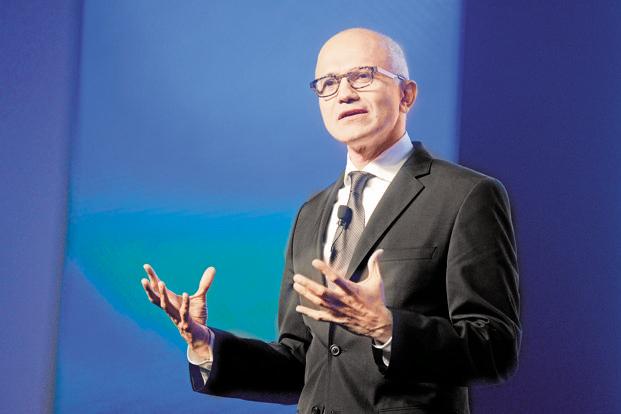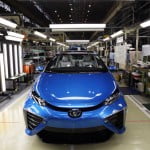Mumbai: Building new types of computers, constructing an intelligent cloud and helping companies increase productivity are the three “interlocking ambitions” he wants Microsoft Corp. to pursue “boldly”, CEO Satya Nadella said in a conversation on Thursday.
Nadella wants Microsoft to help companies reinvent their productivity and business processes with the help of tools like OneNote, Windows 10 and Office 365.
He wants it to build an intelligent cloud with the help of Azure.
And he wants to introduce new types of computers such as the Surface Pro tablet, wearables such as Microsoft Band and mixed reality gadgets such as HoloLens.
All three objectives are aimed at changing the face of computing.
“Every successful company has a core sensibility and a core sense of purpose. For us, it is about powering every person and every organization on the planet to achieve more,” said India-born Nadella, who was named the third CEO in the 40-year-old company’s history on 4 February 2014. He was in Mumbai to deliver the keynote at the company’s largest customer conference in India, christened ‘Future Unleashed’.
Recalling Microsoft’s mission of putting a personal computer, or PC, on every desk and in every home, Nadella acknowledged that the world has changed—from PCs to mobiles.
“In retrospect, that was a goal. Technology has changed. Today is a mobile-first, cloud-first world. In the next 5-10 years, there will be more computing in our lives—computers that we will be wearing on our wrists, on our eyes, in the rooms that we walk into—the big screens, the small screens, and things without no screens like sensors,” Nadella said, adding that the key will be the mobility of experience across all computing devices.
He was insistent that all this will be possible only on the cloud, which is why mobility and cloud should go together. “It’s not the mobility of any one device. That’s truly where technology is going to go,” he added.
On 29 September 2014, Nadella announced during his visit to India that Microsoft will offer commercial cloud services from local data centres by the end of 2015. The firm currently has data centres in three locations, including Maharashtra.
A locally-based data centre will help Microsoft cater to customers’ demands of data residency, regulatory compliance and security issues effectively. The Indian data centre infrastructure market will touch $2 billion in 2016, according to a 5 November note by research firm Gartner Inc.
“We are now seeing the power of cloud manifest in very broad ways, across the entire landscape of India—small businesses, large businesses, public sector, every state,” Nadella said.
He cited the example of Pals Global Solutions, a Hyderabad-based start-up that has built an application which has a mobile front-end, runs on the cloud, and addresses the needs of small farmers across India. The idea is to allow a farmer to find information such as which seed to select, which type of crop to grow, how to avail finance, how to find buyers, and how to intervene if anything goes wrong.
“This entrepreneur was able to take this global cloud technology that was available locally, and use this application. The beautiful thing is that the farmer is already thinking about how to take this app to Indonesia and Africa—an inspiration to every entrepreneur in this country,” Nadella said.
He also spoke about how eyecare company, L.V. Prasad Institute, is looking at clinical data to improve its efficiency. For instance, “the institute recognized a pattern of what happens in post-operative care, what procedures should be followed to make it more efficient. And how to make healthcare more affordable. You can only do this with great leaders and a combination of technology,” Nadella said.
He also cited the example of how Andhra Pradesh is trying to analyse where the dropout rates are going to be high by collecting a lot of data about school enrolments and dropouts in a bid to “allocate the scarce resources to such schools where they can have the maximum impact”.
Nadella said he was also excited about start-ups and e-commerce companies. “It is actually mind-blowing to see how e-commerce is progressing in this country. The estimates I read is that by 2020, India will have about $100 billion of commerce that’s going to happen just as e-commerce. We are already partnering with big e-commerce companies like Paytm and Snapdeal in the country, not only to help them…, but it’s the impact they have across their entire supply chain—their customer base. So Windows 10, Cortana (Microsoft’s digital assistant that uses Machine Learning and competes with Apple Inc.’s Siri and Google Inc.’s Now) and Skype are really integrating e-commerce capabilities of these companies. But small businesses doing e-commerce through these channels are getting more productive due to tools like Office 365 and Azure,” he said.
Nadella is equally excited by the ability of start-ups to change the landscape of urban India. He said his company was launching a special programme as part of the prime minister’s and chief ministers’ Smart Cities initiatives.
Microsoft is the world’s largest software company. But it also makes hardware such as Lumia phones, the Surface Pro tablet, gaming device XBox and the motion-sensing input device, Kinect. Nadella said India will see the fourth edition of Surface Pro (not available currently) by January.
Nadella said his company was in the business of inventing new experiences around computing—like that of “creating a phone that actually gives a PC-like experience”. “We want to innovate in both form and function; in input and in output.” He cited the example of what the company was doing with the “Microsoft Band on one end and HoloLens on the other”.
HoloLens, in particular, is a new computing medium, Nadella insisted. “Until now in our computing history, we’ve always had this history of mirroring what you see in the real world. Desktop is always a metaphor—taking analog to create a digital metaphor. Now, for the first time in our history, we have the ability to superimpose digital content and holograms in an analog world. And once you start doing that, you create a new medium,” he said.
For instance, the way architects will design buildings in the future will change. They can see the building as they are designing it. HoloLens can also influence medical education and healthcare, according to Nadella.
When completing his degree in electrical engineering, Nadella said it was his dream to grasp Maxwell’s equations, which explain how sinusoidal (sine wave, or sinusoid, is the graph of the sine function in trigonometry) plane waves can physically propagate through space. “If I had this tool, I would have understood Maxwell’s equation long back,” he said in jest.
He also expressed excitement over what developers could do with new types of computers. He cited the example of StaffPad that has “changed how music is composed; (it’s) a tool that a composer like A.R. Rehman uses”. StaffPad is an app that takes advantage of the pen and touch input found on Microsoft Surface and other compatible Windows 8.1 devices. As you write notations using the pen, StaffPad recognizes your handwritten music and converts it into a score which you can edit, play back, print and share.
“Satya did great justice to highlight Microsoft’s current strength’s in cloud, and the company’s investments in three data centres locally here in India, and their latest additions of team capabilities to their productivity suite—Office 365,” Sanchit Vir Gogia, chief analyst at Greyhound Research and founder and chief executive of the Greyhound Knowledge Group, said.
“More specifically, he (Nadella) rightly pointed out the strengths in the Microsoft ecosystem in India and their preparedness to support local customers, including the government. Over and beyond, he did fair justice to what can be expected from Microsoft’s corridors in the near future, including HoloLens and Machine Learning among other areas,” he added.
[“source-livemint”]






